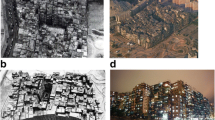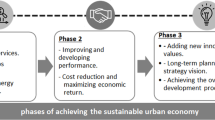Abstract
Sustainable development has many environmental, economic, social, and cultural dimensions. However, Urban Design is considered a critical pillar in ameliorating quality of life and achieving the UN Sustainable Development Goals (SDGs), especially at the local level. Sustainability in urban planning has many aspects, such as decent housing, landscape quality, multimodal transportation systems, and mixed land use; however, the study considers proper density as the most important factor. High density has advantages as it increases the opportunity for social interaction, improved physical health for its inhabitants due to walkability of the space, better public transportation, and better services for the urban community. Those advantages can address SDG 3, 11, and 13. In addition, some cities in hot, dry areas are associated with high density to protect them from the sun and storms. However, high-density areas also have disadvantages, such as potentially causing their inhabitants’ stress. Despite the importance of urban density, the proper and suitable density for achieving sustainable urban communities still needs to be discovered. This chapter tries to determine an optimal range for city density by studying urban planning elements and their density limits using statistic and spatial analysis programs. The relation between density and sustainability is represented in livable, walkable, and other city dynamic variables for achieving sustainable development goals.
Access this chapter
Tax calculation will be finalised at checkout
Purchases are for personal use only
Similar content being viewed by others
Change history
20 October 2023
A correction has been published.
Notes
- 1.
We will explain high medium low density in detail later.
- 2.
Viable: it means more economical.
- 3.
Cost of living:—is a relative indicator of consumer goods prices, including groceries, restaurants, transportation and utilities. A Living Index of 120 it 20% more expensive than (New York) as a baseline.
References
Adlakha, D., & Sallies, J. F. (2020, July 27). Why urban density is good for health—even during a pandemic. Queen’s Policy Engagement. Retrieved December 19, 2022, from http://qpol.qub.ac.uk/why-urban-density-is-good-for-health-even-during-a-pandemic/
Angel, S. (2012). The sustainable densities proposition. Planet of cities. Lincoln Institute of Land Policy, 71–79.
Angel, S., Parent, J., Civco, D. L., & Blei, A. (2010). The persistent decline in urban densities: Global and historical evidence of sprawl. Lincoln Institute of Land Policy, Working Paper.
Berggren, C. C. (2017, June 20). Urban density and Sustainability. Smart Cities Dive. https://www.smartcitiesdive.com/ex/sustainablecitiescollective/urban-density-and-sustainability/241696/
Bertaud, A. (2017, December 17). The spatial distribution of population in 48 world cities. Implications for Economies in Transition. https://alainbertaud.com/wp-content/uploads/2013/06/Spatia_-Distribution_of_Pop_-50_-Cities.pdf
Burgess, R. (2000). The compact city debate: A global perspective. In M. Jenks & R. Burgess (Eds.) Compact cities: Sustainable urban forms for developing countries. Spon Press, 9–25.
Cantera, A. (2020, July 31). Multi-label urban density classification. urbanNext. Retrieved December 19, 2022, from https://urbannext.net/multi-label-urban-density/?fbclid=IwAR3jMogjt0VI8j2U2QM2-gSOlcZIYL30rI_9WewXrDDCOEqMM6Ly0p9QOHU
CAPMAS. (2018, July 1). Estimating the number of the Egyptian population in the sections of cities. https://www.capmas.gov.eg/Admin/PagesFiles/201892594224Untitled4.pdf
Dave, S. (2010). High urban densities in developing countries: A sustainable solution? Built Environment, 36(1), 9–27. https://doi.org/10.2148/benv.36.1.9
Duminy, J. (2021). Beyond growth and density: Recentering the demographic drivers of urban health and risk in the global south. Urban Studies, 0(0). https://doi.org/10.1177/00420980211014410
Edwards, B., & Hyett, P. (2014). Rough guide to sustainability: A design primer (4th ed.). RIBA Publishing.
Frey, H. (1999). Designing the city: Towards a more sustainable urban form. Taylor and Francis.
Hess, P. (2014). Density, urban. In A. C. Michalos (Eds.), Encyclopedia of quality of life and well-being research, 1554–1555. Springer. https://doi.org/10.1007/978-94-007-0753-5698
Habitat III. (2016). The new urban agenda, UN, https://habitat3.org/the-new-urban-agenda/
IBI Group. (2017, December 4). What is the healthiest density for a city. https://www.ibigroup.com/ibi-insights/healthiest-density-city
IBM. (2022). Discriminate analysis. https://www.ibm.com/docs/en/spss-statistics/25.0.0?topic=features-discriminant-analysis
Lehmann, S. (2016). Sustainable urbanism: Towards a framework for quality and optimal density? Future Cities and Environment, 2(1), 1–13.
Lehmann, S. (2010). The principles of green urbanism. Routledge.
Montgomery, J. (1998). Making a city: Urbanity, vitality and urban design. Journal of Urban Design, 3, 93–116. https://doi.org/10.1080/13574809808724418
Newman, P., & Kenworthy, J. (1999). Sustainability and cities: Overcoming automobile dependence. Island Press.
Pew Research Center. (2022, March 31). Households smallest in Europe, biggest in Africa. Pew Research Center. Retrieved December 18, 2022, from https://www.pewresearch.org/fact-tank/2020/03/31/with-billions-confined-to-their-homes-worldwide-which-living-arrangements-are-most-common/ft_2020-03-31_livingarrangements_01/
Pozzi, F., & Small, C. (2005). Analysis of urban land cover and population density in the United States. Photogrammetric Engineering & Remote Sensing, 71, 719–726. https://doi.org/10.14358/PERS.71.6.719
Richardson, H., & Gordon, P. (2020). Compactness or Sprawl: America’s Future vs. The Present. Atlanta, the ACSP Conference. https://lusk.usc.edu/file/340/download?token=IntS7H4Q
Roaf, S., Crichton, D., & Nicol, F. (Eds.). (2009). Adapting buildings and cities for climate change (2nd ed.). Architectural Press.
Statista. (2020). Population density of Amsterdam from 2018 to 2020. Statista. Amsterdam population density 2020 | Statista.
Seto, K., Fragkias, M., Güneralp, B., & Reilly, M. K. (2011). A meta-analysis of global urban land expansion. PLoS ONE, 6(8), e23777. https://doi.org/10.1371/journal.pone.0023777
Teller, J. (2021). Regulating urban densification: What factors should be used? Buildings & Cities, 2(1), 302–317. https://doi.org/10.5334/bc.123
Todes, A., Weakley, D., & Harrison, P. (2018). Densifying Johannesburg: Context, policy and diversity. Journal of Housing and the Built Environment, 33(2), 281–299. https://doi.org/10.1007/s10901-017-9561-6
TomTom. (2021). Trafic study Ranking 2021. https://www.tomtom.com/traffic-index/ranking/
Tonkin, A. (2008). Sustainable medium-density housing: A resource book. Development Action Group.
Tuts, R., Rudd, A., & Swilling, M. (2014). Leveraging density: Urban patterns for a green economy. UN. Retrieved December 19, 2022, from https://unhabitat.org/leveraging-density-urban-patterns-for-a-green-economy
WHO. (2020). Promoting health and well-being throughout Europe. WHO Regional Office for Europe. https://apps.who.int/iris/rest/bitstreams/1365232/retrieve
World bank. (2020). data (worldbank.org). https://data.worldbank.org/indicator/EN.POP.DNST
World Economic Forum. (n.d.). These are the cities with the worst noise pollution. World Economic Forum. https://www.weforum.org/agenda/2017/03/these-are-the-cities-with-the-worst-noise-pollution/
World Population Review. (2022), Amsterdam population. Amsterdam Population 2022 (worldpopulationreview.com).
Yu, J., Gustafson, P., Tran, M., & Brauer, M. (2022, March 2). Assessing trade-offs and optimal ranges of density for life expectancy and 12 causes of mortality in Metro Vancouver, Canada, 1990–2016. International Journal of Environmental Research and Public Health, 19(5), 2900. https://doi.org/10.3390/ijerph19052900. PMID: 35270597.
Zheng, S., Wang, R., Glaeser, E. L., & Kahn, M. E. (2011). The greenness of China: Household carbon dioxide emissions and urban development. Journal of Economic Geography, 11(5), 761–792.
Author information
Authors and Affiliations
Corresponding author
Editor information
Editors and Affiliations
Rights and permissions
Copyright information
© 2023 The Author(s), under exclusive license to Springer Nature Switzerland AG
About this chapter
Cite this chapter
Salem, A. (2023). Determining an Adequate Population Density to Achieve Sustainable Development and Quality of Life. In: Walker, T., Cucuzzella, C., Goubran, S., Geith, R. (eds) The Role of Design, Construction, and Real Estate in Advancing the Sustainable Development Goals. Sustainable Development Goals Series. Palgrave Macmillan, Cham. https://doi.org/10.1007/978-3-031-28739-8_4
Download citation
DOI: https://doi.org/10.1007/978-3-031-28739-8_4
Published:
Publisher Name: Palgrave Macmillan, Cham
Print ISBN: 978-3-031-28738-1
Online ISBN: 978-3-031-28739-8
eBook Packages: Social SciencesSocial Sciences (R0)




